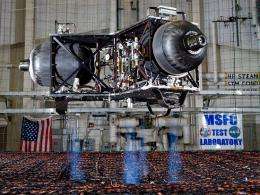'Look Ma, No Parachute!' Lunar Lander Floats on Electric-blue Jets

How do you fly on a world with no atmosphere? Wings won't work and neither do propellers. And don't even try that parachute!
NASA engineer Brian Mulac has the answer. "All it takes is practice, practice, practice," he says. "And of course, thrusters."
The space agency is perfecting the art using a prototype lunar lander at the Marshall Space Flight Center.
"What we've got here is a 'flying testbed' to help us to learn how to hover1 and land on the Moon," says Mulac. He's conducting the tests in collaboration with other engineers from NASA, the John Hopkins University Applied Physics Laboratory, and the Von Braun Center for Science and Innovation.
The electric-blue jets emerging from the lander look like some kind of futuristic high-tech gas, but in fact they are just ordinary compressed air.
"They look blue in this photo because the cold air coming out of the thrusters is interacting with our 'nice' Alabama humidity," explains Mulac. "The plumes are like miniature clouds. They contain ice crystals that scatter blue light."
The center of the prototype has one big thruster to cancel 5/6ths of Earth's gravity. That leaves 1/6 g for the rest of the thrusters--the same as gravity on the Moon.
"This prototype's thrusters are in the same configuration as they would be on the flight robotic lunar lander, so the control algorithms and dynamics are similar," says project manager Julie Bassler.
"That's important," adds engineer Danny Harris, "because we're validating the guidance, navigation, and control system needed for a successful lunar landing."
And if the lander gets out of control? "That never happens," says Mulac, "but just in case, we've surrounded the test chamber with a huge net." The net is visible in the picture as a background network of criss-crossed ropes and would intercept the lander if it ever strayed off course.
So far, the prototype has passed all tests with flying colors: "Once we start a test, it's all autonomous," Mulac continues. "An onboard computer directs the thrusters. The flight profile is pre-programmed. We tell the craft where to go and it goes there on its own."
"By conducting these tests, we gain an appreciation for the design of missions that land on airless bodies," says NASA planetary scientist Barbara Cohen. "Many scientifically interesting places in the solar system are airless. Besides the Moon, we'd like to visit Mercury, asteroids, Europa and other airless destinations. What we learn here could have a broad application."
"It's quite an engineering problem to solve," says Mulac. "With our test bed, we're showing we can do it successfully."
Source: by Dauna Coulter, Science@NASA


















